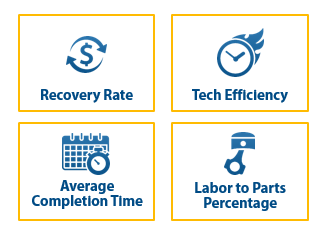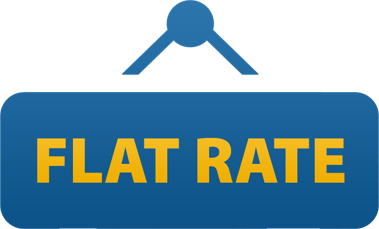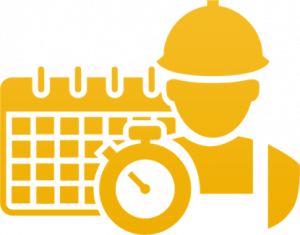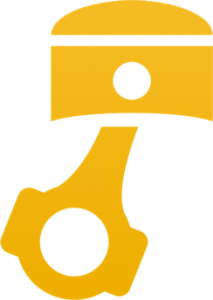Creating Metrics in Your Service Department
Key Metrics to Track
 Everything in business revolves around numbers and each department in your business is unique with what numbers you measure.
Everything in business revolves around numbers and each department in your business is unique with what numbers you measure.
One department dealers tend to struggle with getting the most profitability out of is their service department. Dealers tend to look at profitability in service as the measurement of dollars being sold which, in reality, isn’t the case.
Dealership expert Bob Clements defines profitability in service as the “measurement of how much time you buy and sell on a daily basis.”
“If you hire a tech and pay them to work at your shop for 8 hours each day, you need to measure how well you are at selling those 8 hours to your customer base. Since time is our product, it’s important to understand how it is being used and our effectiveness in producing revenue with it.”
Recovery Rate
In order to effectively measure the time you are buying and selling, Bob recommends that you know your recovery rate.
Your recovery rate reveals:
- What your staffing needs are for the service department.
- How effective your manager is at using flat rates.
- The placement of work by technician’s qualifications.
Recovery rate can be measured in two different ways:
1. Billable time – The time you are buying vs. what you are billing.
2. Turning wrenches – The time you are buying vs. the time the technician is turning the wrench.
Recovery Rate Based on Billable Time
Bob suggests that you need to be looking at your recovery measurements for each individual technician on a daily basis.
At a minimum, a technician should be producing 6.8 hours of billable time for every 8 hours they are paid at the dealership.
Your dealer management software should have reporting tools that allow you to view your technicians’ billable time.
Here’s how the measurement is based:
Recovery Rate Based on Billable Time = Billed Hours/Paid Hours
A technician is not making you money until they are operating at 75% efficiency or better.
For example, if you had a tech with 5 billable hours vs. 8 paid hours, they are operating at a 63% recovery rate, and this technician is not making you money.
Not only do you have to look at the recovery rate for individual techs, you also need to evaluate the recovery rate of your service department as a whole.
As an example, if you have 510 billable hours and 480 hours paid, that’s a 106% recovery rate, which is a great number. It means that for every hour you are paying your service techs to be there, you are making 106% of their time.
How can you boost your recovery rate?
 Believe it or not, you can easily recover over 100% of your time by simply using flat rate pricing effectively.
Believe it or not, you can easily recover over 100% of your time by simply using flat rate pricing effectively.
To achieve those numbers, Bob suggests that you use flat rate labor pricing on at least 80% of your services to hit those goals.
If you’re more proactive on your flat rates, you realistically could add 20%, or more, to your bottom line.
Recovery Rate Based on Techs Turning Wrenches
When it comes to recovery rate based on your technicians turning wrenches, the absolute best you can do is 100% and a good A-level tech can hit those numbers. B-level techs should be recovering in the 80-85% range.
Measuring the recovery rate by turning wrenches can be a key indicator in evaluating the needs of your staff.
Recovery Rate Based on Turning Wrenches = Actual Time/Paid Hours
If 100% is the best and you have a tech operating at 95%, you may need to position yourself to bring in an additional low-level B technician so your A-level technicians can focus on more complex work.
If you’re in a situation where a tech is recovering at 60%, chances are that you’re putting them on jobs that are over their head and better suited for a higher-level technician.
Tech Efficiency
Tech efficiency is probably the most common measurement that comes to mind when you think about evaluating the performance of your service department.
Bob describes tech efficiency as the measurement of how efficient your techs are on individual work orders that are assigned to them.
For example, if you have 6 hours to replace a clutch and it takes the technician 6 hours to complete the job, their efficiency is 100%.
It’s important to understand that for you to have an accurate assessment of tech efficiency for both your individual technicians and your service department as a whole, you must have workstations in the service area where everyone has the ability to clock in and clock out of work orders using your dealer management system.
Some systems even include mobile capabilities that will allow them to clock in via a mobile device.
Bob views time as an inventoried item, therefore you have to treat it like the rest of your inventory. Techs should always remain clocked into some type of work order.
Once you have the data from your techs in your system, you can start measuring your tech efficiency.
Tech Efficiency = Billed Hours/Actual Time clocked on a WO.
For example, if you bill your customer 3 hours and it takes your tech 2.5 hours to complete the work, they are operating at 120% efficiency, which is at an A-level.
Your B-level techs should be performing in the 85% to 100% range on 80% of their work.
Low tech efficiency can be impacted by:
- Techs are being assigned jobs that are well above their skill level.
If a tech is not skilled at electrical diagnostics and he is working on an electrical issue, there’s a chance he could spend 6 hours on the job and only bill 1 hour.
- You’re not assigning the proper amount of labor time based on equipment condition.
Once again flat rates come into play. When assigning labor rates based on equipment conditions, Bob recommends:
Excellent to good condition – charge the flat rate time
Good to fair condition – add 20% to the flat rate time
Fair to poor condition – add 50% to flat rate time
- Improper parts ordering or pulling.
If parts are ordered incorrectly, or not pulled in a timely matter, it’s easily going to impact the time a tech takes on a work order.
- Bad equipment staging.
This can have a huge impact on your technicians’ time. When equipment comes in for service, you must keep that equipment organized and easily accessible. The worst thing you can do is have a tech spend 15 minutes or more trying to find the equipment they are supposed to work on next.
- Improper tools or lack of equipment to complete a job.
If you don’t provide the necessary tools in your shop for your techs to complete their work efficiently, it will have a negative impact on their efficiency.
To begin seeing a significant increase in tech efficiency, it’s important to eliminate any of these roadblocks that can have a negative impact on their performance.
Average Completion Time
 The easiest way to improve customer satisfaction is to schedule your customer’s work and turn it back out when the customer expects it to be done. In order to give your customers an accurate assessment of when their work will be done, you need to measure your average completion time.
The easiest way to improve customer satisfaction is to schedule your customer’s work and turn it back out when the customer expects it to be done. In order to give your customers an accurate assessment of when their work will be done, you need to measure your average completion time.
Completion time = The average time it takes a tech to move a work order from an open status to closed status.
To calculate this metric you need to look at:
Completion Time by Tech + Actual Time Tech is on WO/Completed WOs
This calculation can be accessed through reporting tools in your dealer management software.
For example, if you have a tech that spends 32 hours on work orders and completes 18 work orders, it takes them 1.78 hours to take a work order from an open to closed status.
You also need to look at your completion time for the shop:
Completion Time for Shop = Total Actual Time/Total Completed WOs
If you know how many hours it takes for the shop to take an order from open to closed, you can multiply that number by your open work orders and you’ll know how far you are behind within a couple hours. This will help you schedule the new jobs that come in.
For example, if you are 15-16 hours behind in work and your customer brings equipment in for service, you can order the parts now and you will know to schedule the repair 15-16 business hours from now.
Bob generally recommends you schedule within a 4-hour window of your estimated time.
Labor to Parts Percentage (LPP)
 The last key metric you need to take a look at is your Labor to Parts Percentage. This metric is defined as how many dollars you sell through the service department in parts vs. the labor.
The last key metric you need to take a look at is your Labor to Parts Percentage. This metric is defined as how many dollars you sell through the service department in parts vs. the labor.
LPP = Part Sales/Labor Sales
For example, if you do $2,500 in parts sales through your service department and $3,800 in labor sales, your labor to parts percentage is 66%. The lower your labor to parts percentage, the higher your comeback rate tends to be.
When calculating this metric, it’s important to note that you need to make sure you separate your counter parts sales from your labor parts sales.
Making the Numbers Work for You
By knowing the right metrics to analyze and understanding what impacts those numbers, as well as how to improve your performance, you’ll easily start seeing an increase in the profitability of your service department.
Ideal has worked with Bob Clements to incorporate service metrics into its software so dealers can easily access key metrics and better analyze the performance of their service department.
